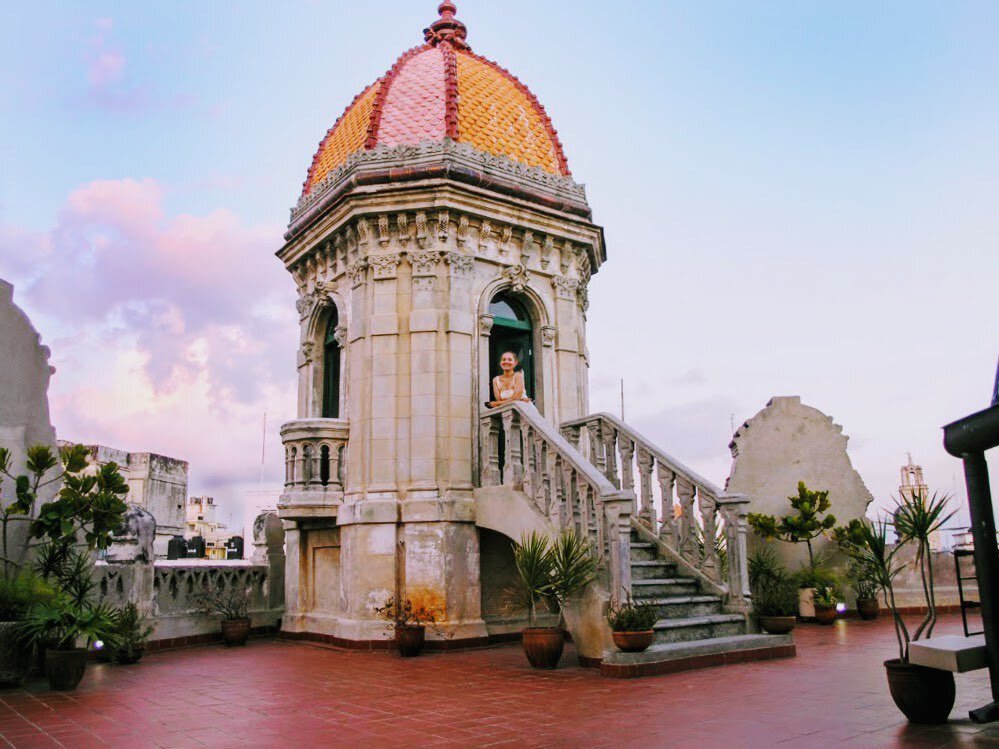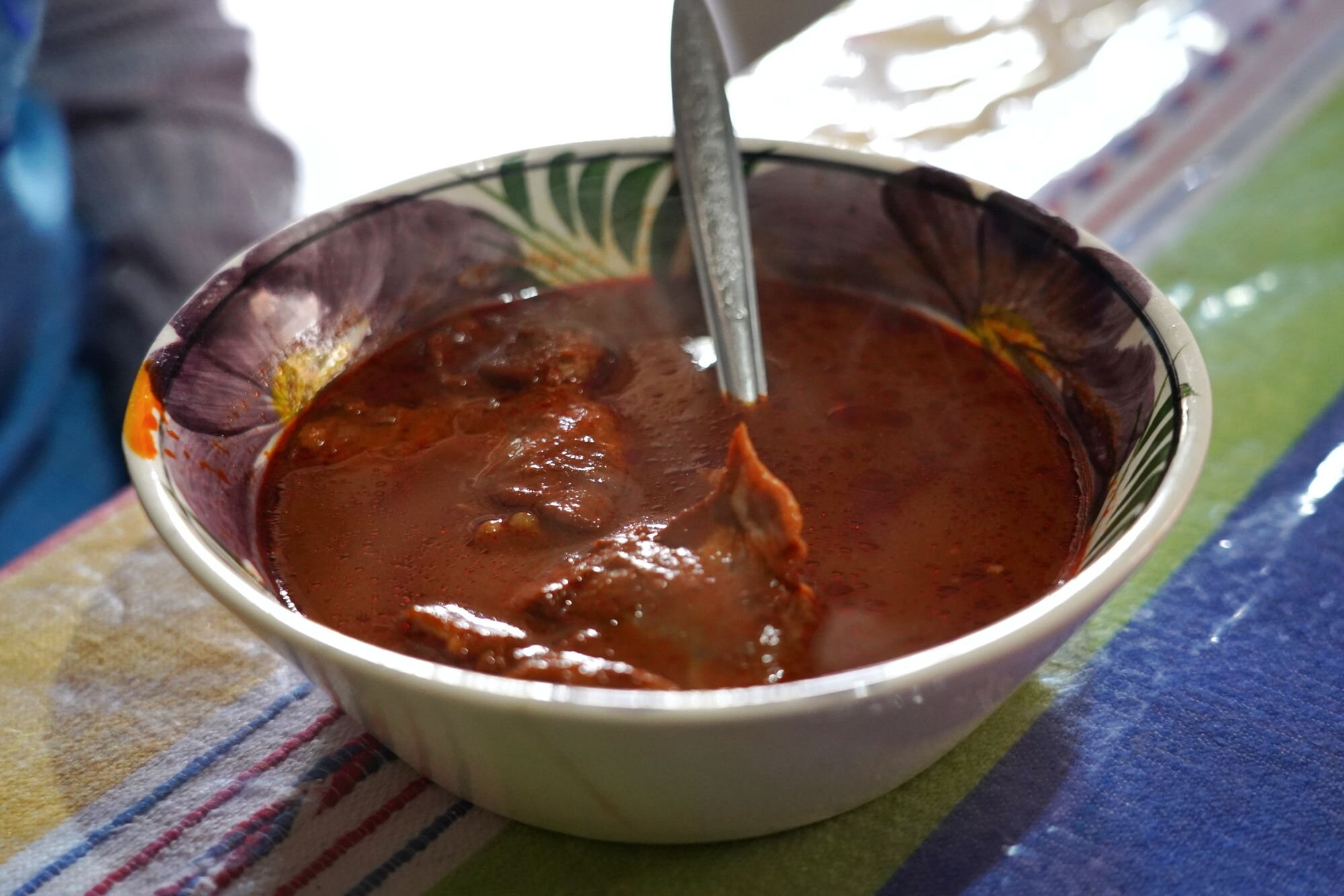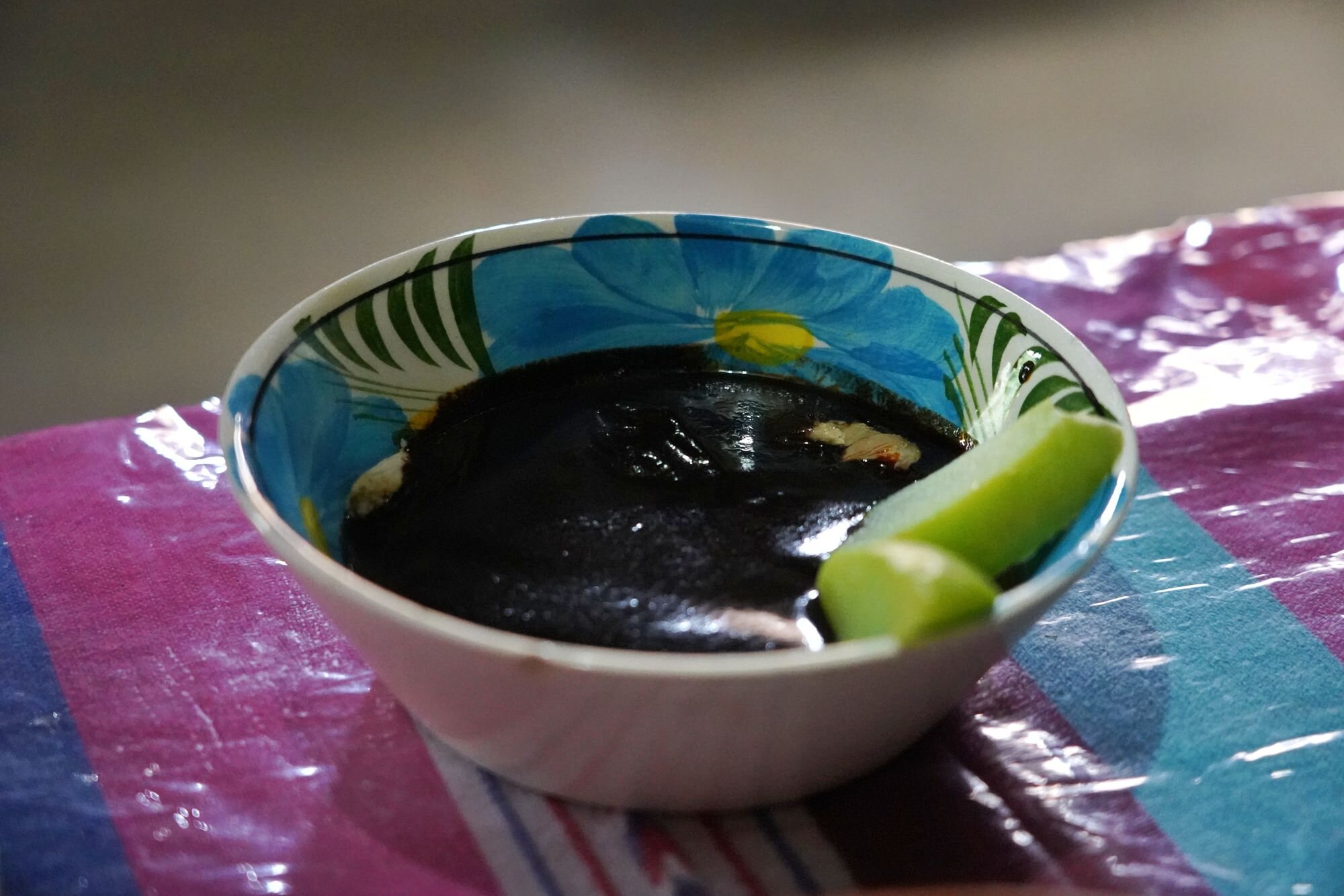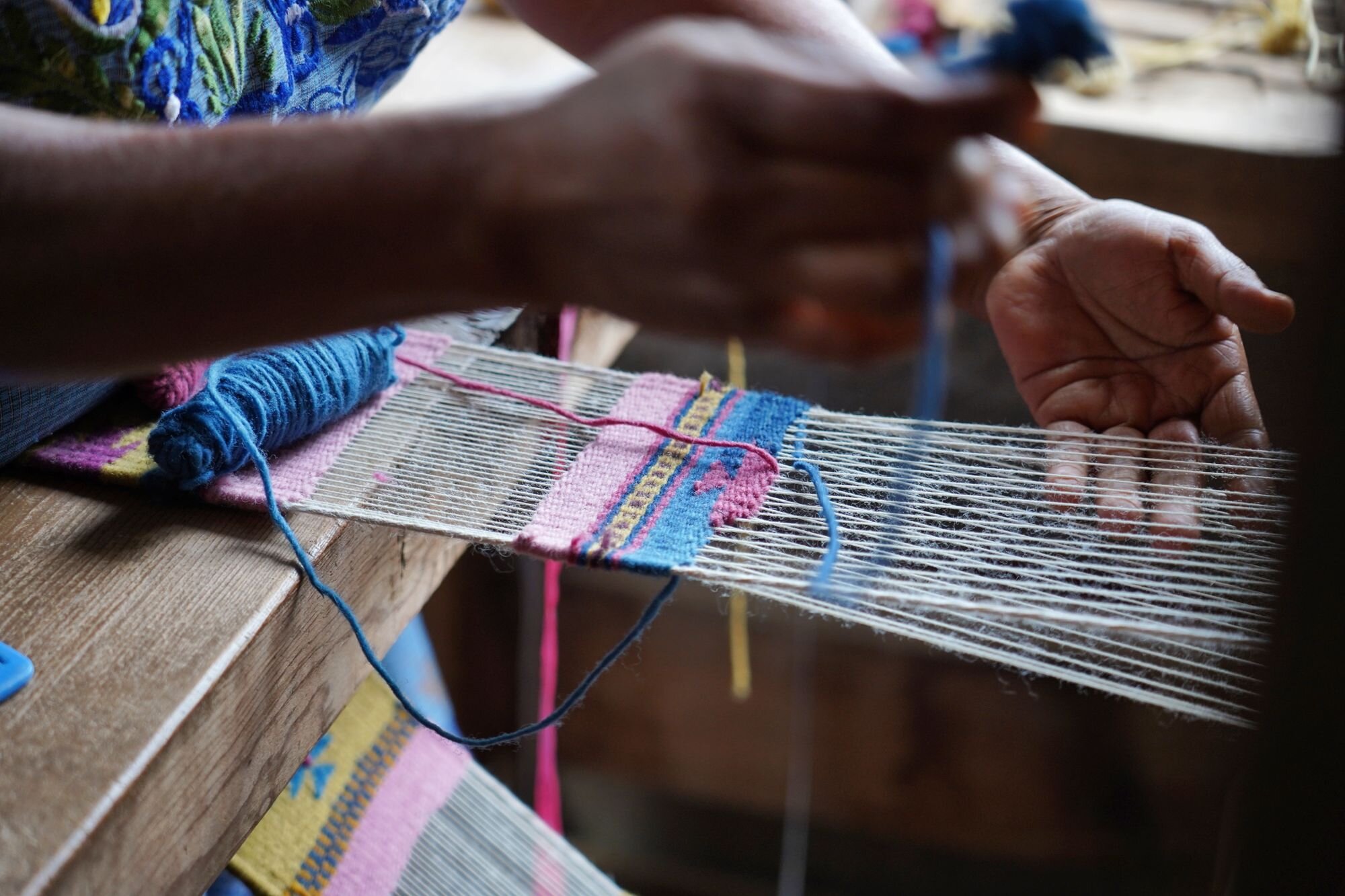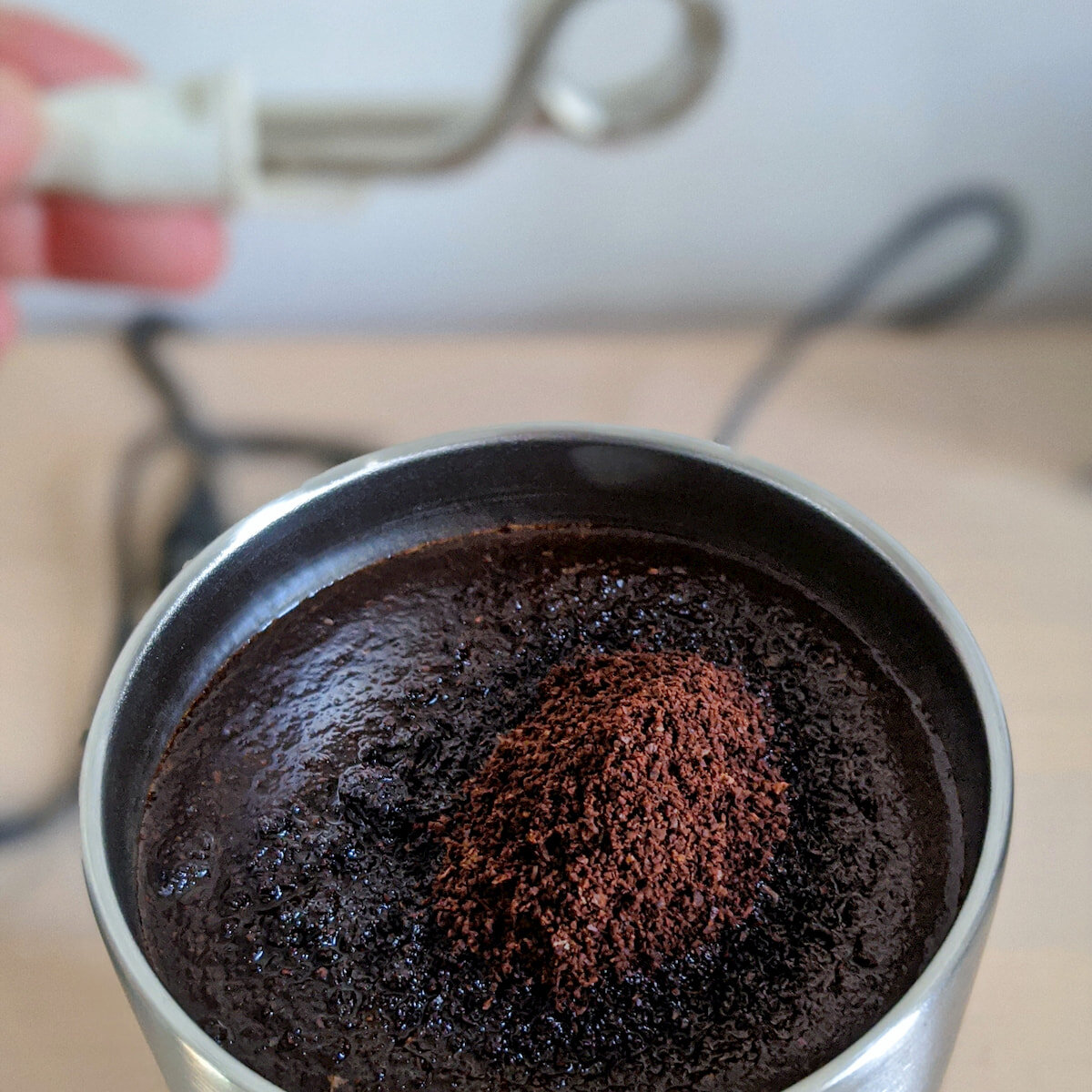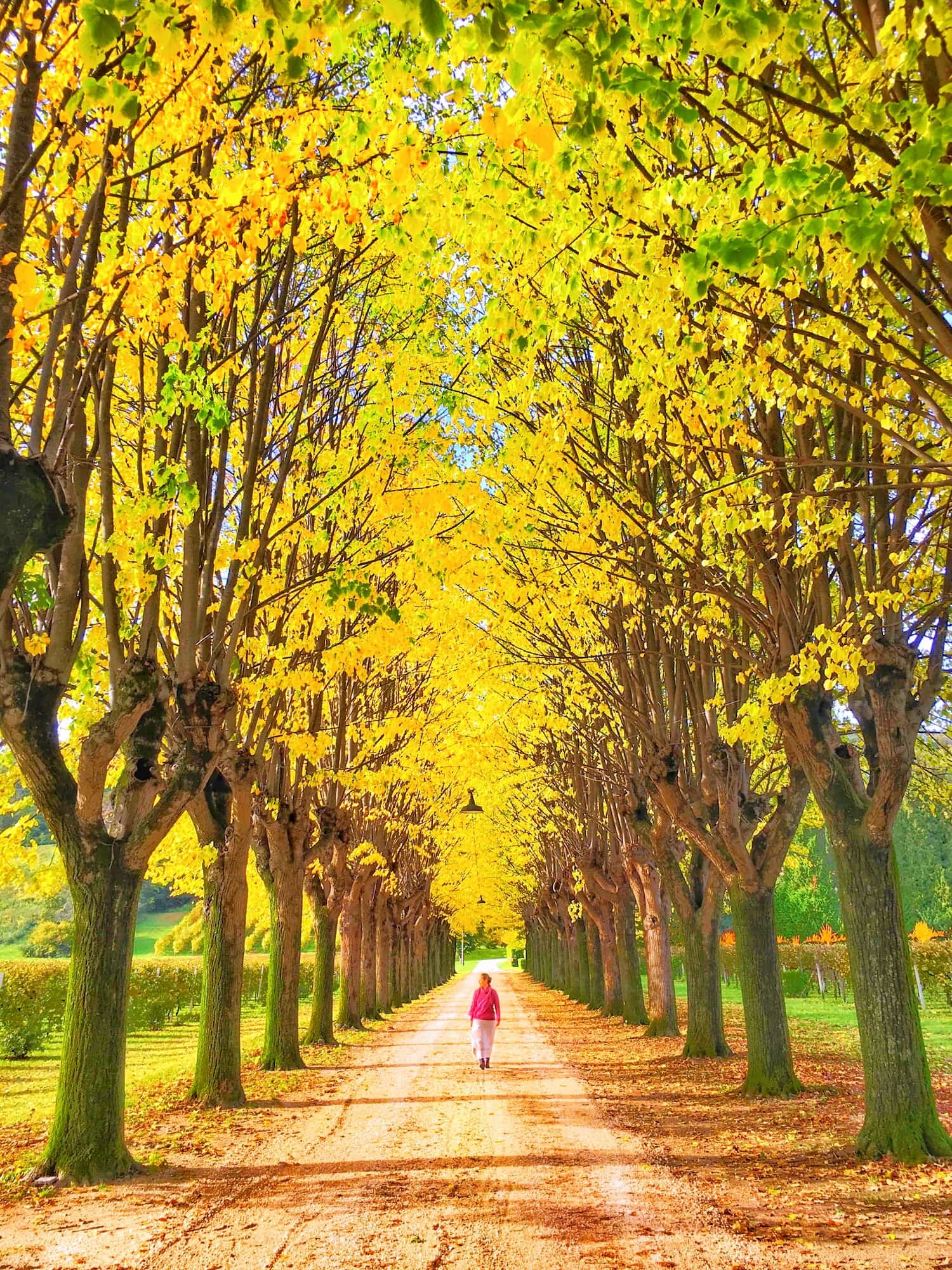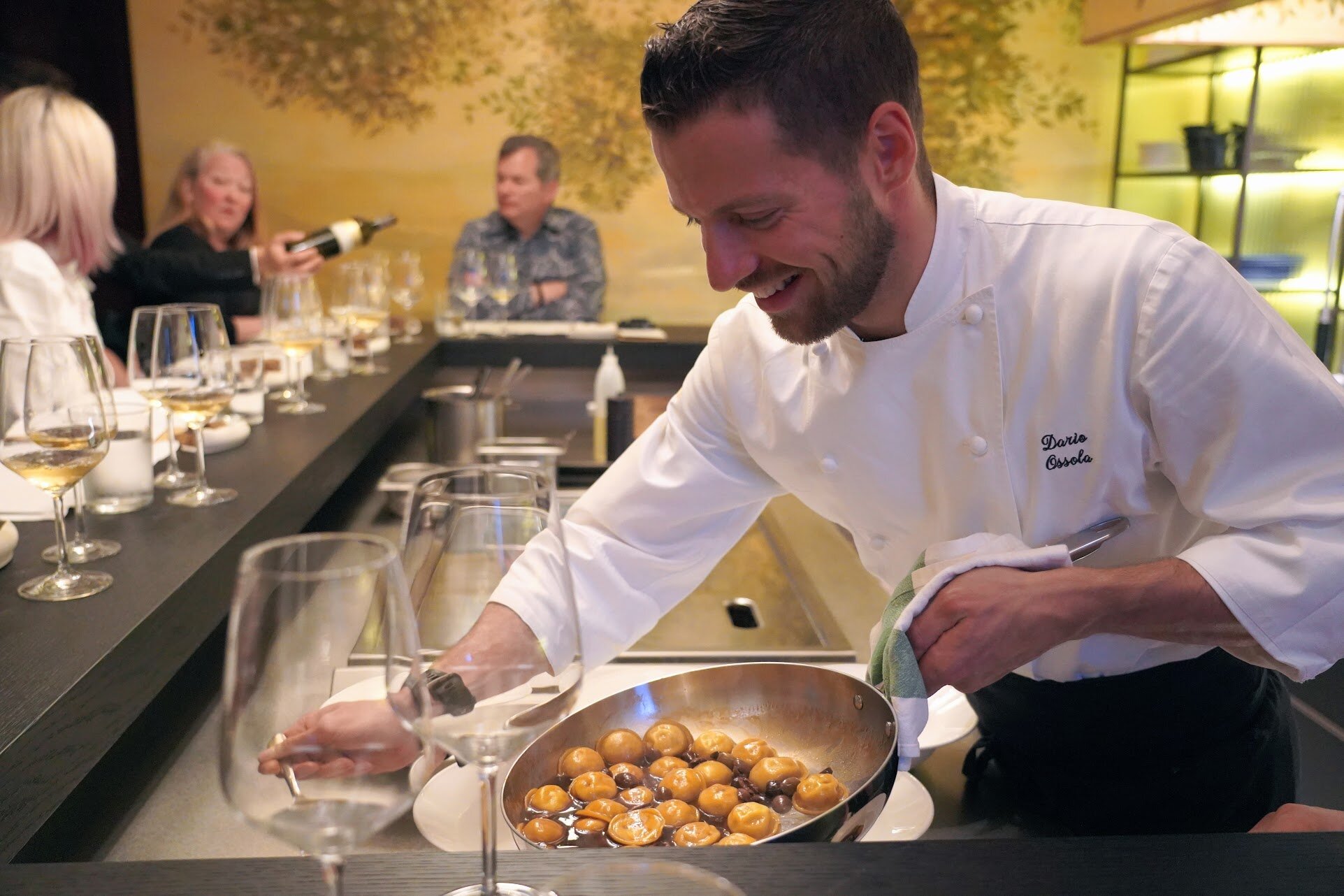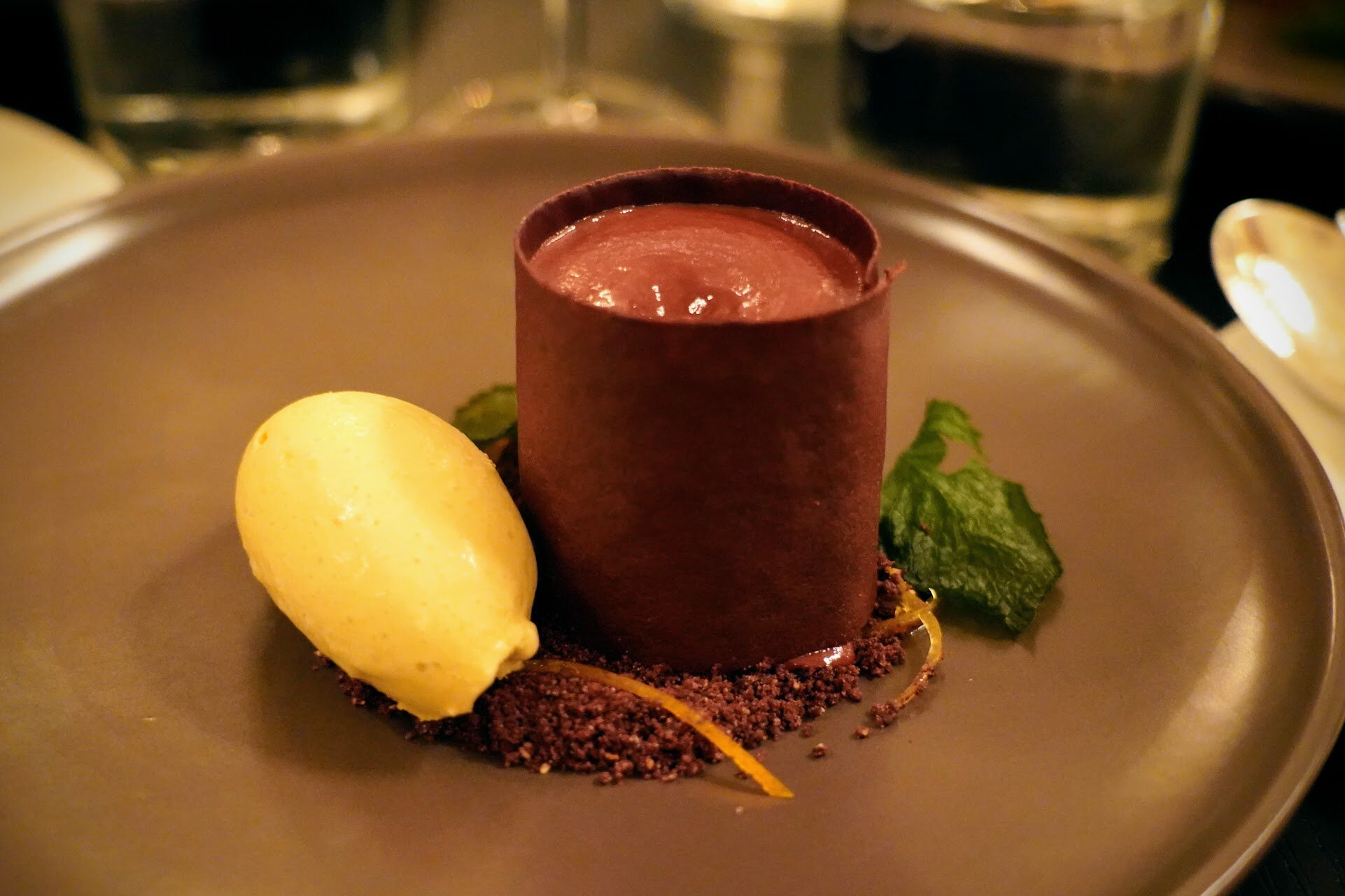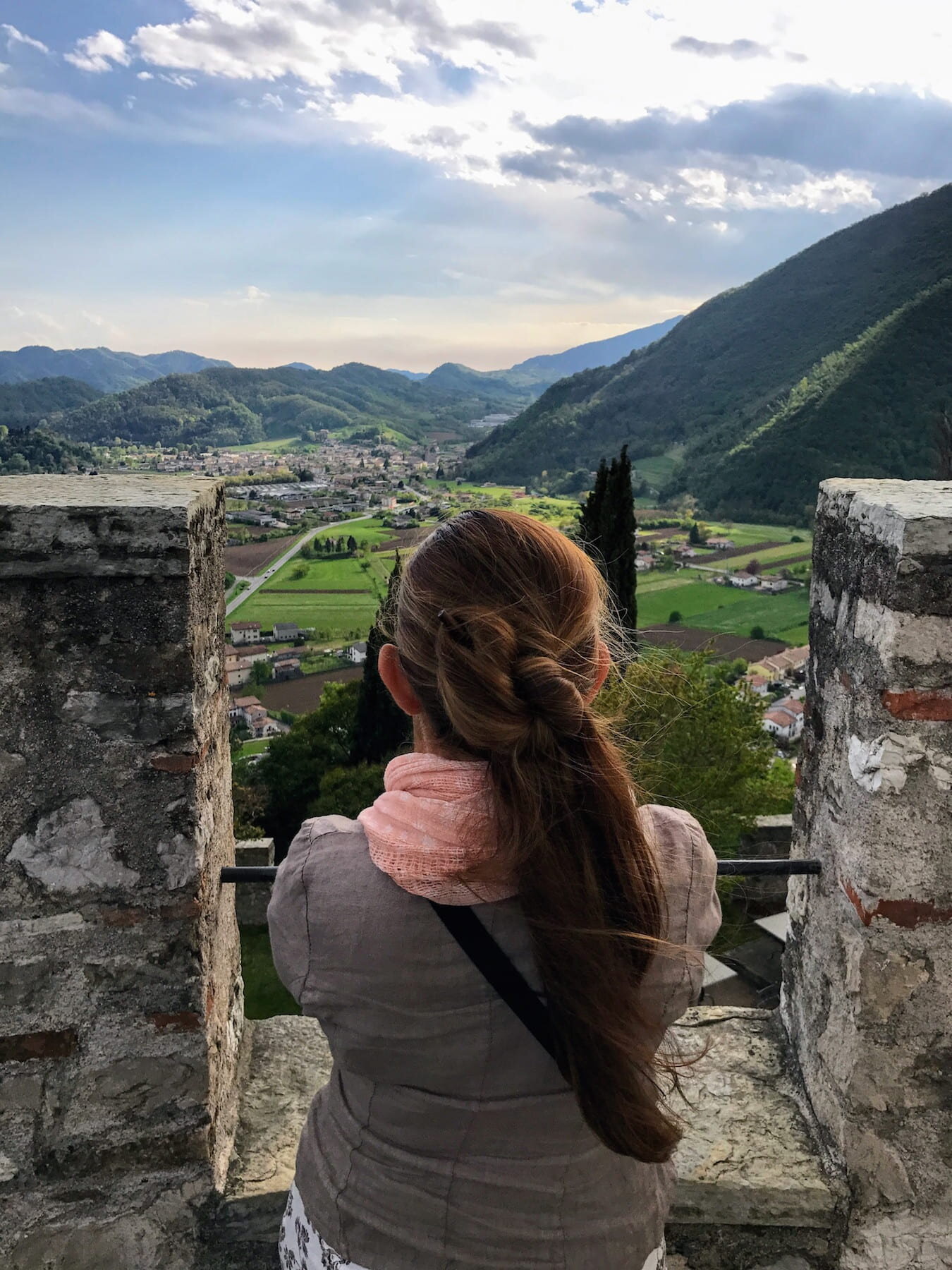Another treat from the Tlacolula market here in Oaxaca, Mexico: cheese made with chilis. You would think this would be super spicy, but the chilis are all very mild and the cheese is mild, too. It’s got very subtle flavors. The indigenous market sellers use banana leaves as the “packaging.” So delicious.
Amira picked up some turkey eggs at the market
These two turkey eggs Amira bought at the Tlacolula market here in Oaxaca, Mexico, are just plain big. We’re going to make omelets with them later.
Anatomy of the perfect tamal
These were the most delicious, authentic and, well, perfect tamales we have ever tried. Heirloom corn masa, super flavorful locally grown beans and — the pièce de résistance — wrapped in the herb hoja santa, then corn husks. The salsa is handmade, medium hot from some relatively obscure chilis, smokey and wonderful.
Hoja santa, which is amazing when well used but not so great when cooks and chefs don’t know how to use it, is native to this region (Oaxaca, Mexico) and used by the Aztecs as medicine and even in chocolate.
The corn to beans ratio is also perfect. Nearly all modern tamales are overstuffed with too much cheap GMO corn. This is how they used to be made, with far less higher quality corn.
Note that all these ingredients are prehispanic and local — no cheese, chicken or other imported ingredients.
This stuff has ruined me for hot sauce
First things first: When we arrive in Oaxaca, we grab a jar of this stuff. Macha is oil made spicy with pepper flakes. It also contains peanuts for flavor. It’s very hot and very tasty.
Of course, Amira makes a much better chili oil, loaded with garlic as well. But this will hold us over until she can get to the local markets to buy the stuff she needs. -Mike
Traveling to Oaxaca to explore the food, culture and architecture of this Mexican gem
Waking up in Oaxaca to the chirping of birds and the hum of this city on the second day of spring was nothing short of glorious. Even after arriving exhausted from California, being in Oaxaca again is a dream come true. We had been scrambling to get ourselves ready to reclaim our digital nomad lifestyle after sheltering in place for many months. (Note: This post is an excerpt from the Gastronomad Newsletter.)
We’re living in a traditional Oaxacan house, which belongs to a friend of a friend. It’s as pleasant as can be and perfect for doing the work Mike and I do. It has a nice big kitchen with lots of natural light where I can work on creating recipes for the Spartan Diet Journal.
The house has a wonderful open air courtyard where hummingbirds love to visit and we enjoy watching them from floor-to-ceiling windows as we sit in front of our laptops every day. We have a nice hipster bakery cafe next door — the smell of baking butter is wafting through the windows as I write this.
Travel is even more meaningful than it used to be somehow. Mike and I have truly loved our lifestyle and always feel so grateful and blessed. But traveling and seeing our Oaxacan friends again makes us so happy (even if we can't hug and we have to meet outdoors keeping distance and wearing face masks).
Pandemic woes are temporary. But Oaxaca is eternal.
Oaxaca is a state. But the history and culture (including food culture) of Oaxaca centers on the Oaxaca Valley in the Sierra Madre Del Sur Mountains.
The Zapotec civilization ruled the Oaxaca valley between around 700 BC until two years after the first Spanish set foot on the Mexican mainland (around 1521). Although there are many indigenous languages spoken in the State of Oaxaca today, the main language group is Zapoteco, which has 7 distinct languages and more than 100 dialects. It's mainly these Zapotec peoples — their farming and food practices — that make Oaxaca such a unique culinary paradise.
Mexico is the food capital of the Americas, and Oaxaca is the food capital of Mexico.
The Spanish brought the food cultures of the Arab world (having previously expelled the Moors from Spain, but not their food culture) and Asia (having established a trade route between their various colonies, including in the Philippines and elsewhere in Southeast Asia). But no import could rival the incredible food types of the native Americans in general, and Southern Mexico in particular. This tiny tropical area, from the Oaxaca valley to Guatemala, and from the Pacific to the Atlantic, gave the world the cultivated or domesticated varieties of corn, chocolate, tomatoes, tomatillos, avocados, chilis, squashes, turkey, papayas, vanilla, jicama, chia seeds, allspice, many species of beans and hundreds of spices and herbs.
What's different about Oaxaca compared with many other Mexican regions is the combination of specific types of food production, plus the existence of 16 officially recognized indigenous groups faithfully preserving ancient foods and food practices.
While all of Mexico's "greatest hits" are present here — (amazing hot chocolate, corn tortillas, sweet breads, sweetened watery drinks and all the rest — Oaxaca is especially well known throughout Mexico for many traditional dishes and drinks originating in the region. Some of the more well known include:
mole
Oaxaca is called the "Land of the Seven Moles" because each of seven regions in the area is said to specialize in a specific type of mole that's different from the other six. These general mole types are black, red, light red, chichilo, green, yellow and manchamanteles (stainer of tablecloths). In fact, the "seven moles" label is an oversimplification or even a marketing fabrication. Despite this categorization, moles do vary widely from household to household and from seller to seller. Both the variety and quality of moles to be found in Oaxaca is overwhelming. (Mole is simultaneously the most Mexican and the most international food ever created, typically containing ingredients originating in the Americas (North and South), Europe, Asia and Africa.)
tlayudas
A tlayuda is a large (about the size of a medium pizza) thin tortilla roasted on a comal or over fire and topped with beans and a combination of other ingredients including lard, avocado, some kind of meat, Oaxacan cheese and salsa.
quesillo
Also known as Oaxacan cheese, quesillo is like a slightly more flavorful mozzarella or string cheese. Dominican friars brought the mozzarella idea from Italy to Oaxaca and used cow’s milk instead of buffalo milk. It's made into long ribbons and then bound up like a ball of yarn via the pasta filata process. While clearly an Italian import, the centrality of quesillo to Oaxacan dishes and also the quality of the cheese from Oaxaca makes it central to this region.
Oaxacan tamales
While tamales are universal to Mexico, every region has its different varieties. Oaxacan tamales are wrapped in banana leaves (as is common throughout tropical Mexico and Central America, and often contain uniquely Oaxacan moles).
tetelas
Tetelas are made with corn masa wrapped around a filling that can include beans, chilis, pork, mushrooms, cheese and other ingredients, folded into a triangle shape, grilled and then topped with sour cream, cheese and even roasted grasshoppers.
memelas
Memelas are thick corn tortillas shaped to be filled with a spread of refried beans, lard, quesillo and topped salsa (similar to sopes). They’re shaped like tiny pizzas with a little border around to keep the filling inside the open face memela.
chapulines
Also found throughout Mexico, chapulines (roasted grasshoppers) are especially associated with Oaxaca because of the quantity and variety available in the Oaxaca Valley. Local markets feature baskets of different types piled high and sold by the kilo. They can be eaten in or on various foods, or just eaten by themselves by the handful with chili, lime, garlic or onion and salt.
mezcal
One of the world's most exquisite, complex and sophisticated distilled alcohol drinks, mezcal is made from the agave plant (maguey). Before mezcal can be made, a mezcalero has to wait at least 7 to 9 years to begin the harvest and distillation process as most agave plants take at least 7 years to reach maturity at which point they can be harvested. Some wild agave species take 30 years to reach maturity. While mezcal is made in various regions around Mexico (including tequila, which is just one of the many varieties of mezcal), the vast majority is produced in the Oaxaca valley, which features vast agave plantations like the California wine country features vines. To make most mezcal types, the spikey leaves are cut off and the center "pineapple" is chopped, cooked underground, mashed, fermented and distilled using traditional handcrafted methods that go back generations. Different mezcales have different characteristics based on the type and age of the plant, the terroir of where it's grown, the harvesting, cooking, fermentation and distillation processes, the ingredients added for flavor (including in rare cases turkey meat or specific worms), the style and amount of aging and other factors.
pulque
Pulque, which is fermented agave juice, is to mezcal what beer is to whiskey — it's the same basic ingredient fermented rather than distilled. Before the Spanish arrived, pulque was a drink mainly for the upper classes of native societies, and also used ritualistically. Before the 20th Century, it was drunk more commonly than beer. Pulque is a delightfully sweet and sour drink by itself, and also flavored with fruit juices and other flavorings. In our experience, Oaxaca has the best-tasting pulque we've encountered in Mexico thus far.
The cultural expression of Oaxaca is apparent not only in its gastronomy, but also architecture, art, and preservation of its indigenous traditions that reward the senses with flavors, colors, aromas and beauty.
We're here mainly to continue preparing for the upcoming 2021 Oaxaca Experiences, which will bring people together from abroad to introduce them to local friends and the local community, as well as the beauty and deliciously unparalleled splendor of Oaxacan culture.
This will be a once-in-a-lifetime culinary and cultural immersion to experience Oaxaca’s authentic expressions of flavors, aromas and colors through a deep exploration of its food, beverages, architecture, folk art and handmade crafts as well as the warmth and wisdom of its people. We hope you get to enjoy this epic travel adventure. -Amira
The wonderful world of horchata
Note: This is an excerpt from the free Gastronomad email newsletter. Click here to subscribe.
Everywhere you go in Mexico, you can find wonderful beverages called aguas frescas — water-based refreshments. And these typically have some natural flavor, plus sugar. So you can find hibiscus, tamarind, pineapple, cantaloupe, guava, passion fruit, watermelon and dozens of others.
We have them in the United States, too. Just about every restaurant or street vendor in the US will offer at the very least lemonade or iced tea, both of which are "aguas frescas" — natural flavor, sugar and water.
One of the most interesting agua fresca is horchata, which is widely available in Mexican restaurants and taco stands in the United States. I suspect that most Americans and probably most Mexicans think horchata is from Mexico. In fact, the Americas are merely the final destination for a beverage that goes back thousands of years.
Americans got horchata from Mexico. Mexico got it from Spain. Spain got it from Valencia. (Valencia was independent from Spain when Spain conquered Mexico.) Valencia got it from North African Muslims (the "Moors"). The “Moors” got it from Egypt. The Egyptians got it from sub-Saharan Africans in what is now Nigeria and Mali.
They've been drinking horchata in that part of Africa since at least 2,400 B.C -- and they still drink it there. They call it kunnu aya.
The truth is that horchata has a long history, and every culture that embrace it made it their own.
Horchata began as a drink made from an African weed called cyperus esculentusk by the scientists, and colloquially as chufa sedge, chufa nut, nut grass, yellow nutsedge, tiger nut sedge, tiger nut, edible galingale, water grass or earth almond.
The weed also grew in the Americas. Plants in the tiger nut family were used as a food source by Native Americans, Africans and others at least 9,000 years ago.
(Our word "horchata" comes from the Valencian word "orxata." Because of New World bastardizations and novel ingredients, the Valencians now call it "horchata de chufa" to differentiate the newer innovations.)
Everybody changed it. The Africans and egyptians drank their tiger nut drink straight. The Moors or Valencians probably added sugar and cinnamon. The Spanish in the New World swapped the tiger nut for local substitutions.
Mexicans have always made horchata with rice. Central Americans use a roasted seed called morro. Various countries like Puerto Rico and Venezuela added sesame seeds. Ecuador makes pink horchata using flowers and herbs.
Both Mexicans and Americans started adding milk and other ingredients and flavorings. You can find crazy innovation and mashups around horchata in trendy restaurants in the US and Mexico. Now you can get horchata coffee drinks at Starbucks, horchata cocktails at bars and restaurants and find other variations on the horchata theme.
Regardless of nomenclature, horchata's journey is just like any other food's journey, traveling across geography, time and culture and evolving as it goes.
We have lived extensively in three of the major horchata-obsessed places — Valencia, Mexico and El Salvador — our favorite by far is Salvadoran horchata made with morro, which is flavored with cinnamon, nutmeg, coriander seeds and allspice. Horchata there is sweet, but that sweetness is balanced by a nutty roasted flavor that's amazing.
The place most obsessed with horchata is Valencia, which lack's Mexico's incredible diversity of drinks, but which does use tiger nut to make it. Valencia is Europe's only major producer of tiger nut, and they cultivate their own variety that doesn't exist outside of Valencia.
But we also love Mexico City’s best rice-based horchata during our Mexico City Experience (pictured) and enjoy very good Horchata during our Oaxaca Experience.
Horchata is a wonderful drink no matter where you enjoy it. But enjoying the local varieties in the places where they make it is a true joy.
Traveling back in time through the architecture of Cuba
Strolling through the music filled streets of old Havana is like traveling back in time. With its eclectic architecture reminiscing of cultural influences that go back to its indigenous roots and settlement by the Spanish, Cuba’s architecture is a fusion of baroque style and neoclassicism.
The colorful old buildings wear their age with grace. And though many look dilapidated, these pastel colored buildings still stand majestically, defying time and neglect. Even when they look like complete derelicts, they still provide shelter for many families.
These are the kinds of buildings that elsewhere would have been razed to the ground long ago to make room for malls, car dealerships and modern office buildings.
Wandering through the streets of Habana Vieja, as the locals call it, you can experience the charm of Cuba in a true sense like nothing else. And on the rooftops (that's me peeking out of a hotel rooftop structure where we enjoyed an exquisite candle-light dinner), the city looks otherworldly or, more to the point, from another time.
How to Travel to Europe without Going Into Quarantine
Most Americans believe that Europe is closed to them, thanks to the failure of this country to contain the Covid-19 pandemic.
Another widely held belief: Travel spreads the coronavirus.
Both these beliefs are false, and we'll tell you why. The truth is that you CAN visit Europe without delay, and you CAN do this safely and without spreading or contracting Covid-19,
How to fly to Europe
Europe is famously closed to American travelers, but there are cracks in that wall, for two reasons: 1) there are European countries that welcome Americans; and 2) there are countries that will welcome Americans without quarantines as long as they arrive on specific airlines with specific testing programs.
The most welcoming country in Europe right now is Croatia. Americans are welcome, as long as they either self-isolate for 14 days before travel or have received a negative Covid-19 test within the 48 hours before travel. Not only is Croatia in Europe, it's part of the European Union.
There are a few other cracks in the Great Wall of Europe.
American Airlines will sell you at-home covid tests for $129 each for international travelers to London from New York, Los Angeles and Dallas. (This week they announced tests for domestic travelers in the US starting Dec. 12.). Travelers will need to quarantine for 14 days in London after arrival, unless they get a negative test on day 5 of the quarantine, at which point they're free to leave quarantine. (The airline is partnering with home testing company LetsGetChecked. The test kids include a nasal swab, which you send through the mail. Results are sent to you within a few days.)
You can also travel to Europe without going into quarantine.
Delta Air Lines and KLM Royal Dutch Airlines are partnering to offer passengers a way to skip Amsterdam's current 10-day quarantine requirement and Rome's 14-day requirement, through testing. They'll have to take three tests. One a few days before flying, one at the Atlanta Airport before flying, and a third upon arrival in Amsterdam or Rome. If their three-week trial works out, they'll extend it to other destinations.
Other airlines are working on similar trials that will result in Americans flying to Europe.
How to travel safely
All these ways to travel to Europe involve extensive testing, which is fantastic. This not only assures that Americans arrive in Europe virus-free, but it also makes the flight itself virus-free.
Testing is one of the steps on our Save Travels pledge.
Beyond our pledge, it's true that "tourism" is irresponsible in the age of covid. But living like a Gastronomad is not. The idea is to shelter in place in another place, observing all the coronavirus protocols like mask wearing, social distancing and extreme hygiene.
In other words, going to indoor restaurants, concerts and bars; shopping in crowded cities like Barcelona; and failing to wear a mask are wrong.
Going to and staying at a farmhouse, keeping your distance, cooking at home, shopping at outdoor markets and exploring outdoor sites without getting within 10 feet of other humans is great.
Travel does not spread the coronavirus. Failing to observe anti-virus protocols (whether traveling or not) is what spreads the coronavirus.
It's time to think about traveling to Europe again.
What we learned during the lockdown
The world has changed. And our lives have changed with it.
Hard to believe, but it was only last spring when a big chunk of the world's population went into lockdown because of Covid-19.
It's now autumn. And as seasons come and go, we remain hopeful that, individually and collectively, we'll continue to adapt to the new world of global pandemics. (We’re even more hopeful now that Pfizer has announced a new vaccine with 90% efficacy.)
After seven months of hunkering down in Silicon Valley, we decided to go to live in Oaxaca, Mexico, for a while.
Like everyone else, we’ve missed many things. But not having the privilege to travel and gather with friends around the world hosting the Gastronomad Experiences has been a serious bummer for us.
Still, we’re among the lucky ones. We feel so humble and grateful for the tremendous support from our Gastronomad community across the world and, especially, you, our Gastronomad family. You have shown us patience, trust and understanding. Thank you for your willingness to wait for the right time for each of the Gastronomad Experiences to become feasible.
There’s so much unpredictability surrounding the pandemic. We’re trying our best to navigate these challenges as pandemic outbreaks keep re-emerging in different parts of the world.
There’s promise in the air, however. We have a new president elect and a vice-president elect who are competent, and I'm sure will do all they can to fix what’s broken.
A great deal of things have transpired during these past eight months for me and Mike as a couple and as a family business.
Frankly, the seven months we spent sheltering in place in the US meant a drastic change for us. I experienced a profound loss of belonging, as most of the world closed its doors to travelers, especially from the United States, where the pandemic was grossly mismanaged. It’s not something we ever imagined could happen.
As digital nomads, we chose the world as our home -- not a structure with walls -- but whatever country or place we happen to be living in. The pandemic created the strangest of circumstances. Our digital nomad lifestyle meant we had no home of our own. And the travel bans meant we had no place to go.
When we returned from Mexico City last March after hosting our only Gastronomad Experience this year, we were lucky enough to be able to go into lockdown with our oldest son and his family in Silicon Valley.
Personally, Mike and I tried to make the most of our time under lockdown. Still, I cried too much, I’ve spent too many sleepless nights feeling the weight of everything. It crushes my soul that there are so many people suffering everywhere. I’ve felt heartbroken about all the people deeply impacted by the pandemic and the wildfires in California.
But we did our best to cultivate joy and to adapt to our new pandemic living situation. We cooked a lot, ate delicious homemade meals, grew an edible garden, enjoyed backyard picnics, listened to music and danced. We had Zoom parties and reconnected with beloved relatives. We even took a few socially-distant road trips to Oregon, Washington and Los Angeles.
We took so many long trips that we almost finished off our old 2006 Toyota Prius. So we got a new one so we could keep driving long distances.
And we also bought seventeen and a half acres of forest land in Washington State. We’re not ready to settle down there, or anywhere. But after experiencing the shock of sudden bans on travel, we decided to buy a place that’s ours.
We’re so deeply grateful to our son, his wife and our granddaughter for sharing not only their home with us but also their family life with us. It’s in situations such as these that you learn what unconditional love is.
We’re also profoundly grateful to relatives in New York, Oregon and Washington who offered to open their homes to us despite the pandemic. I feel forever indebted to them for their kindness and selfless gesture in willing to take their chances with us in the middle of a pandemic.
And while there’s no question that this terrible pandemic has been awful, there has also been a silver lining. We’ve been forced to find new opportunities, to reinvent ourselves, and to adapt and grow.
After all, life is fragile and our time is limited. I have felt hopeless at times. But then I find my way again, realizing that my best path is to live by our values to the best of our ability. All we can do is to not let fear rule us, and to try our best to live with courage, compassion, kindness and joy.
And in that spirit, Mike and I decided to emerge from lockdown in Silicon Valley by traveling to Oaxaca, Mexico. We did a lot of research and talked to our local friends here before coming. We also did major research on how to travel safely. It’s been incredibly rewarding and fulfilling living here in Oaxaca.
We’re following all our Safe Travels guidelines. Yet I feel an enormous sense of liberation and freedom.
We know that others don’t have the privilege to do what we do. But we're trying to reclaim our life, which we've been cultivating for the better part of 14 years.
These are strange times that have forced us all to put our travel dreams on hold and postone all the Gastronomad Experiences scheduled for all of 2020 (prior to Covid-19). Our promise is that all of the Gastronomad Experiences will happen, not until it’s safe. Your safety is of our top priority (followed by your joy and delight).
I find some comfort in the fact that our approach to travel, our travel philosophy, is not only a healthy way to explore the world but also more relevant than ever. It’s a sustainable, mindful and more environmentally friendly way to travel. Inherently, the Gastronomad Experience is the safest way to travel in the post-pandemic era.
We go to a place to learn about the local culture, we live like temporary locals, we honor local traditions, we look for the paths less travelled, we explore slowly and with purpose and we immerse ourselves in the community wholeheartedly adopting the locals’ way of life as best we can. We try to discover the unsung foodie heroes and also embrace the well known food visionaries and stewards of the Earth.
So many years of living across the world wandering freely and never imagining that an event such as Covid-19 would force us to quarantine with no option to travel for a time. Not having the freedom to live the life we chose. It’s definitely been a poignant and significant lesson. It made us appreciate everything even more and with different perspectives.
Sometimes it takes almost losing what we love to understand how lucky we are to still have it.
Our Day of the Dead in a tiny village in Oaxaca
Amira and I were invited by our friend Dalia to her indigenous, Zapotec-speaking village in the middle of Oaxaca to join her traditional Day of the Dead celebration. Dalia is an amazing cook who grows all her own food and makes everything from scratch. Here are some of the highlights of our day.
Dalia made for us a regional specialty called atole con chocolate, which is a white corn drink very common throughout Mexico, but with a local twist: white-chocolate foam. She ferments a white variety of cacao under ground for three months, adds a little wheat, then grinds, sifts and froths it using a wooden Aztec hand mixing stick. This is the chocolate foam before being added to the atole.
Here’s the completed drink. It’s truly delicious and wonderful.
Dalia’s barbacoa is made from lamb from her own flock.
They make giant, very thin and crispy tortillas around here made from their own corn that they grow and usually mill by hand using an Aztec stone grinder called a metate. Amira got involved. Amira is wearing a kind of apron vest called a mandil, which they loaned her as a way for her to be part of the group.
This is the wood fired comal Dalia uses in the corner of her kitchen.
Dalia’s barbacoa is mind-blowingly good.
Here’s Amira enhancing the barbacoa in the traditional way with lime, cabbage with cilantro and green salsa all from Dalia’s garden.
Dalia’s mole negro, made very traditionally with more than 30 ingredients, is one of the best I’ve ever tasted.
After lunch we spent some time with Dalia’s ofrenda.
Dalia lit the candles.
Masks off for a moment so that Dalia could ritually purify Amira with copal, a flower they gather in the mountains and turn into incense.
We had a nice long walk through the village to Dalia’s mother’s house.
The ofrenda at her mother’s house is dedicated to her father, who passed away five years ago.
Dalia offered us some mezcal from a plastic jug. They buy it from a place that dispenses it from a barrel.
The multitalented Dalia also weaves. She makes rugs, table runners and more, all stunning.
She showed us how it’s done.
These are her naturally-dyed wool yarns, which she dies by hand using plants either picks wild in the mountains or grows in her garden.
These are tiny coasters!
Before leaving, we enjoyed these baked apples. Dalia just tosses them on the coals (in Spanish: Al rescoldo), then peels and slices them. We drizzled them with wild honey. The perfect ending to a very sweet visit.
Taking chips and salsa to the next level
Everybody loves chips and salsa. On our Gastronomad Mexico City Experience, we turn it up to 11, enjoying heirloom corn tortilla chips and salsas made with the rarest varieties of chili peppers. (These are grown only in Oaxaca and are used by only two or three exclusive restaurants in the city.)
A Gastronomad truism: Food always tastes best in the land where it originates. It’s about tasting the terroir of food, and also learning from the people that grow and make food with so much passion that your taste palate is forever transformed with every bite.
Join us in Mexico in 2021 for the Mexico City Experience or the Oaxaca Experience! Get ready to have your mind blown and palate thrilled by these delicious culinary adventures of a lifetime!
Ask me about next year's Gastronomad Experience!
We’re planning the most amazing, epic, life-changing foodie travel experiences ever! Ask me anything right here!
Why pistachios are right for pizza
You’ve heard about pizza, right? Crust. Tomato sauce. Mozzarella cheese. Maybe some pepperoni slices, and a few other random veggies and cured meats, like sausage.
And nuts.
Wait, what?
Pistachios are one of the most wonderful ingredients you could ever put on a pizza. But it has to be the right kind of pizza.
We discovered this fact at Pizzeria Bianco in Phoenix, Arizona, many years ago. That place makes a pizza called the Rosa, which has red onions, Parmigiano-Reggiano, rosemary and pistachios, drizzled with olive oil. It’s fantastic. (Picture below.)
A couple years ago, we were spending some quality time in Turin, Italy, and showed up at an extremely popular restaurant called Pizzeria Fratelli Roselli. It was a rainy day, and we were exploring the town by walking around. Normally, to get a table, you have to make a reservation weeks in advance. But they were nice and told us they had a table that wasn’t reserved for another half hour. We said we’d eat and run in 20 minutes.
One of the pizzas we ordered broke all the rules (which, of course, there are no rules in pizza — the only necessary ingredient that makes pizza pizza is the crust). This one had no sauce. It did have a thin layer of mortadella bologna on the dry crust with a huge ball of Burrata cheese on top and drizzled with olive oil. And crushed pistachios. Truly wonderful pizza.
We made pizza this week at home, using our usual sourdough crust. We made several kinds of pizza, but one had a tiny amount of sauce, mozzarella and Pecorino Romano cheeses and onions. After one bite, it was clear: This pizza really needed some pistachios. (Won’t make that mistake again!)
Why we love African safaris
We spend some amazing months in Kenya a few years ago, and one of the incredible things about that time was the safaris we did. We did safaris in Land Rovers, in jeeps, in boats and on foot. One of the life-changing aspects about these adventures is that they often go near places where amazing animals spend time, turn off the vehicle’s engine and just sit there. You get to watch animals just being themselves.
Early one morning, we got pretty close to some young cheetahs, and watched them lounge, play, run, jump into trees and just basically be cats — at unbelievable speeds. We saw the carcasses of large gazelles high up in trees, where the cheetahs somehow drag them.
Like all cats, cheetahs are killing machines. But they don’t attack humans in the wild. In fact there has never been a reported case of a human being killed by a cheetah. And the reason is interesting. While animals like lions and hyenas evolved to take down big, strong animals that can fight back, the cheetah can only kill animals whose only real defense is their speed — gazelles and other swift-moving deer. So cheetahs leave the large mammals — including people — to the lions, and specialize in chasing down ultra-fast runners.
It’s one thing to hear about all this. It’s transformative to see it with your own eyes. When the pandemic is over, we think you should definitely put an African safari on your bucket list.
Thoughts on the post-pandemic world and the future of travel
We’ve been so happy to hear from many of you and are so glad that you’re healthy and faring well under the circumstances.
It’s been about two weeks since our return from Mexico. We went from socializing and partying to social distancing and disinfecting. Quite a change. (We brought back Mexican alcohol -- a little mezcal and a lot of rubbing alcohol.)
After spending fourteen years roaming the world and returning every year to our favorite places on this beautiful planet, we find ourselves holed up in Silicon Valley, California, barely going even to the store.
Not being able to travel makes me feel trapped. But it's the price we've got to pay to help the nation cope with a lack of medical staff, tests, resources and a vaccine.
It’s normal to feel sad and worried as we witness and endure the consequences of this terrible pandemic. The devastation to small businesses, people’s livelihoods, people’s health, the economic downturn and all the deaths are beyond heartbreaking.
Luckily, we’re with our son, daughter-in-law and adorable, enchanting and endlessly entertaining granddaughter, Princess Squishyface, who manages to be cuter and funnier every day.
We’re doing our best to enjoy life in a different way.
We’ve been checking in with all our friends around the world. Their locations span the crisis spectrum, from our friends in Northern Italy, which is in the middle of an unmitigated catastrophe, to Mexico, where the real impact is still weeks into the future. We're grateful that everyone we know, personally, is OK.
(Speaking of friends around the world, these photos were sent to us by Erik, a Venetian who drives his boat for us in Venice during The Prosecco Experience. Normally, Venice is a poster child for overtourism; right now, it's deserted, the water is clearing up and the streets and canals are quiet.)
We have so much gratitude for all the healthcare workers and governments around the world working diligently to save lives and contain the spread of COVID-19. We’re grateful for everyone involved in growing, distributing and making food, despite the risks.
As we all try to adapt to life with COVID-19, it’s our sincerest hope that you are able to cope with all the sheltering in place and social distancing and any other impacts from this crisis.
The pandemic makes me realize how we have taken our way of life on this planet for granted. It’s a big lesson indeed.
But treading more lightly is long overdue. Embracing a more sustainable way to live on this planet while co-existing with each other is not only a necessity but actually something deeply rewarding.
Enjoying the simple things as well as a slow way of life are things our usually hectic and fast-paced world makes us neglect and overlook. Instead, we perform acrobatics with our schedules and make shopping an olympic sport. We find comfort on compulsive consumerism while we forget the very things that make us human and lose some of our humanity alongside.
Getting reacquainted with our kitchens and spending more quality time around the table eating, talking, playing and laughing with our loved ones are precious but almost extinct rituals that we have been forced to embrace again.
It seems that the less we have the more gratitude cultivates in our hearts. Perhaps this is the only way that this could have happened.
And now spring is upon us and there’s promise of lush greens, wild flowers with sunny warmth and the bounties of nature.
This is a great time to plant seeds or seedlings and get a vegetable garden going, or at least some potted herbs if you don’t have the luxury of a yard. I got some seeds last time we were in Oaxaca (less than a month ago!). And I just bought some organic soil so I’m all set to give this a go.
Negative events are often an opportunity to do something positive. So we’ve been cooking and baking a lot enjoying candlelight dinners and also practicing our homesteading skills -- and some dance moves!
Fermentation is something both Mike and I love. I made a ton of sauerkraut recently. Mike has baked sourdough bread every day. I fed and harvested our raw red wine vinegar and apple cider vinegar. Also, my kefir is doing well and happy to be fed on a regular basis for a change. Our son, Kevin, is making kombucha and organic beer so we’re well covered in the fermentation department.
The goal is to find the silver lining to this crisis we’re all confronted by. And when I say "all," I mean every single human being on this planet. It's hard to grasp the significance of that.
As I talk to friends all over the world, I see that they and we are similarly challenged by the same threats and effects of the coronavirus pandemic.
We’re in this together, in the broadest possible sense of the phrase. We are one global community as a human race having to rise the challenges of the most life changing event of our lifetime.
None of us are on different sides. We’re not fighting wars with each other. We're fighting this pandemic as the human race. We’re fighting one common threat to each and everyone of us.
Even as we have to observe social distancing, we’re connected more than ever before. There are no borders, boundaries or divisions between us. Our connection this time goes beyond gender, geography, social economic factors and race as well as cultural and religious differences.
We have to learn, grow, adapt and survive together because it’s literally the only way.
This will pass. One day this will be a distant memory, and hopefully, we’ll be practicing the lessons learned.
As we look back, we’ll share a bond of shared sacrifice that made us re-embrace our natural roots as human beings gathering in solidarity and joining our efforts collectively for our own survival. A time that forced us to reflect and live more sustainably for a better and stronger future -- not just as a nation but as a planet and global community.
More than ever, we need to support one another and especially those enduring serious hardship, whether they’re our loved ones, friends or other organizations and small businesses. There’s so much need out there for being good neighbors, good relatives, good friends, good citizens, good customers and good human beings. Our acts of generosity and kindness are what will make the difference in someone’s life during this crisis.
For now, we can be grateful for the time to enjoy some quiet introspection. Hopefully, we’ll come out on the other end stronger, wiser and kinder.
And we can look forward to the future when we can keep exploring the world across oceans and experience other cultures that inspire us and nourish our souls.
Life is for celebrating and travel is the most fulfilling and meaningful way to celebrate life!
-Amira
A personal note from Mike & Amira
Dear Gastronomad friends and fans,
We hope you and your family and friends are healthy and happy during these suddenly challenging times.
We’re in Mexico City where The Mexico City Experience just ended. If you've joined us on any Gastronomad Experience, you know that during Experiences time stops and all the troubles in the world are forgotten.
The coronavirus hasn't really arrived in Mexico to speak of yet, but this country is about a month behind the United States in a nationwide ban on gatherings, voluntary social distancing and runs on the stores.
So while the United States went from normalcy to extreme changes, we enjoyed a profoundly joyful and delicious week filled with parties and epic meals, cultural immersion and exploration with local Mexican food-visionary friends. On the last night (or, rather, yesterday morning) we danced until 2:30am to happy tunes of salsa, cumbia and bachata!
But it's Monday, and the party is definitely over for awhile. We'll be flying to California tomorrow for self-imposed social distancing and isolation until it's safe to emerge again.
As COVID-19 continues to be a major concern for each of us (and our friends and families), we are committed to making sure that all future Gastronomad Experience attendees will remain safe from not only the coronavirus, but all illnesses, infections and injury.
The Morocco Experience Update
Morocco has suspended all international passenger flights to and from its airports as protective measures against the coronavirus and, as such, the sold-out Morocco Experience previously scheduled for April 10 through April 23 is postponed. The Morocco Experience will be rescheduled, but we don't have new dates yet.
The Provence Experience Update
The sold-out Provence Experience June 22 through June 27 is still happening and won't be postponed unless there are travel restrictions in place close to the time of the Experience.
Thankfully, the Provence Experience is 3 months and 2 weeks away so we remain hopeful that by then, the coronavirus madness will have subsided and travel will be more or less normal.
We'll be in touch with the latest developments as the weeks go by. Best case scenario is that the coronavirus crisis passes long before the remaining Gastronomad Experiences this year and all can go ahead as planned.
Some are concerned that even after the viral crisis has abated, the airlines may still not fly. But this is extremely unlikely. The airlines need to get back to normalcy as soon as possible in order to survive as businesses, and nations need global travel to survive economically.
We apologize for the inconveniences and are deeply sorry that we're all being negatively impacted by the frenzied response to the coronavirus pandemic worldwide.
The coronavirus is quite possibly the most life-changing event of our generation. And as common sense tells us to follow the voluntary movement of social distancing, it’s important to remain committed to living life with intention and joy, whether we're traveling the world or staying at home.
Life has presented us all with a great challenge, and all we can do is rise to it. Let's do all we can to help the people most affected by this outbreak, and re-commit ourselves to health, love and compassion for those less fortunate.
We’re thinking of you and send all our love.
Amira and Mike
How to make coffee when you're packing super light
I normally buy a giant bag of Peet’s coffee whenever I’m in the US, and carry that with me when we’re abroad. I also carry my AeroPress and filters for making coffee (I don’t have the AeroPress Go yet) directly into my Yeti Rambler, which is a stainless steel insulated coffee delivery system (it’s a travel mug, basically).
Sometimes, like now, we travel super light. Most of our stuff is back at our Mexico City apartment, including the AeroPress. We’re in Oaxaca for the week, and we packed super light — only carry-on. That’s when I go into super nomad mode for coffee.
I use a portable immersion water boiler, and I boil water directly in the Yeti Rambler. Once the water is up to temperature, I pour the coffee, and the coffee brews as the grounds sink to the bottom. Boom! Coffee, with the least-possible amount of equipment for the lightest-possible packing.
The joy of making (and eating!) Mexican mole
We love mole. Especially after what we experienced on Sunday, thanks to our friend (and Mexico's chile expert, Fernando).
Wait, mole? What's the deal with mole?
Most people think of mole as profoundly and exclusively Mexican. And, of course, that's true. But it's also probably the most international foods ever created. In fact, no food represents the Columbian Exchange more than mole.
Mole is a product of Spanish colonialism. The exact origins of mole are unknown. But we do know that recipes first emerged in the early 19th Century. And the moles you find today all over Mexico contain ingredients from Mexico, Europe, Africa and Asia. The states of Puebla and Oaxaca are most closely identified with a next-level culture of mole.
Inside Mexico, the regional variations and family recipes add up to probably tens of thousands of individual varieties. The variety of moles is endless. But what they have in common is two core Mexican ingredients -- chiles and chocolate. Beyond those ingredients, most moles contain between 20 and 40 ingredients, with some containing more than 100 ingredients. These include nuts, dried fruit, seeds, cilantro, seedless grapes, plantains, garlic, onions, cinnamon, black pepper, achiote, guaje, cumin, cloves, anise, tomatoes, tomatillos, garlic, herbs and more. Some moles even contain finished foods, such as tortillas or cookies.
(Outside Mexico, you're likely to encounter a bland, one-dimensional version of mole poblano.)
Mole is usually used as a sauce for meat or tomales, and also a marinade. At Mexico City's famous Pujol restaurant, mole is served as a course -- they bring you a plate with mole on it, which you eat with a tortilla.
Because of the wide variety of moles easily available at markets, and because of the internationalization and industrialization of Mexico's food culture, the art of making mole is being lost.
That's why Fernando and his family decided to stop this loss of culture, and learn how to make mole by making mole. Once they master the art of traditional mole making, they plan to teach others how to do it.
(Fernando's family owns a market called La Flor de Jamaica. And Fernando teaches our Gastronomad Experience guests all about chiles and salsa. He's also dedicated his life's work to preserving the knowledge, culture and botanical diversity of chiles and other Mexican food plants. That's Fernando pictured below wearing the giant hat.)
On Sunday, Fernando and his family (and we) all got together to make mole and other delicious foods completely from scratch using traditional methods over wood fires. This process of experiential learning was lorded over by an older woman who had learn from her mother and grandmother, and also a professional cook.
Most of the mole ingredients were toasted over a wood fire on a comal, then ground with a large flat volcanic-rock grinding stone called a metate and a hand-held stone called a metlapil.
This turned out to be a wonderful, slow, relaxing way to spend a beautiful Sunday in a small town in the state of Mexico, just South of Mexico City.
We basically ate all day, took turns grinding mole ingredients, hung out, chatted and ended up having a mind-blowingly fantastic mole chicken dinner.
We are so lucky to have a friend like Fernando, who generously invited us to participate in this day with his wonderful family. And Mexico is lucky to have a man like Fernando working so hard to preserve the nation’s unparalleled gastronomic culture.
Picturing the Picture-Perfect Prosecco Experience!
You owe it to yourself to explore with us the beauty and wine and gastronomy of The Prosecco Experience. We still have room for our May and September Prosecco Experiences.
San Salvador: North America's coolest undiscovered metropolis
Everyone should live in San Salvador, at least for awhile. As the gigantic old capital of El Salvador — 1.5 million people larger than San Francisco and a century older than New York — San Salvador is a major and historic city.
We spent nearly a week there straddling New Year’s Eve, staying in a brand-new condominium with a stunning view (the picture was taken out of our living room window).
It made us wonder why more Americans don’t visit San Salvador. The answer is probably crime, poverty, earthquakes and volcanoes, all of which are active in San Salvador, but none of which is likely to affect you.
San Salvador is in many ways like any other city — there are Starbucks, hipster cafes and Crossfit gyms popping up everywhere. But unlike many cities, San Salvador has clean air, friendly people and a very rustic countryside always minutes away.
The weather is amazing. It reaches a high in the mid to high 80s every day, all year. The only different in weather is that sometimes it’s very rainy. Other times its very windy. But it’s always pretty warm during the day.
The best thing, of course, is the food. Salvadoran food is incredible, and incredible food is everywhere.
In any event, one week was too short. So we’re trying to figure out how we can stay in San Salvador for a lot longer next time.

















